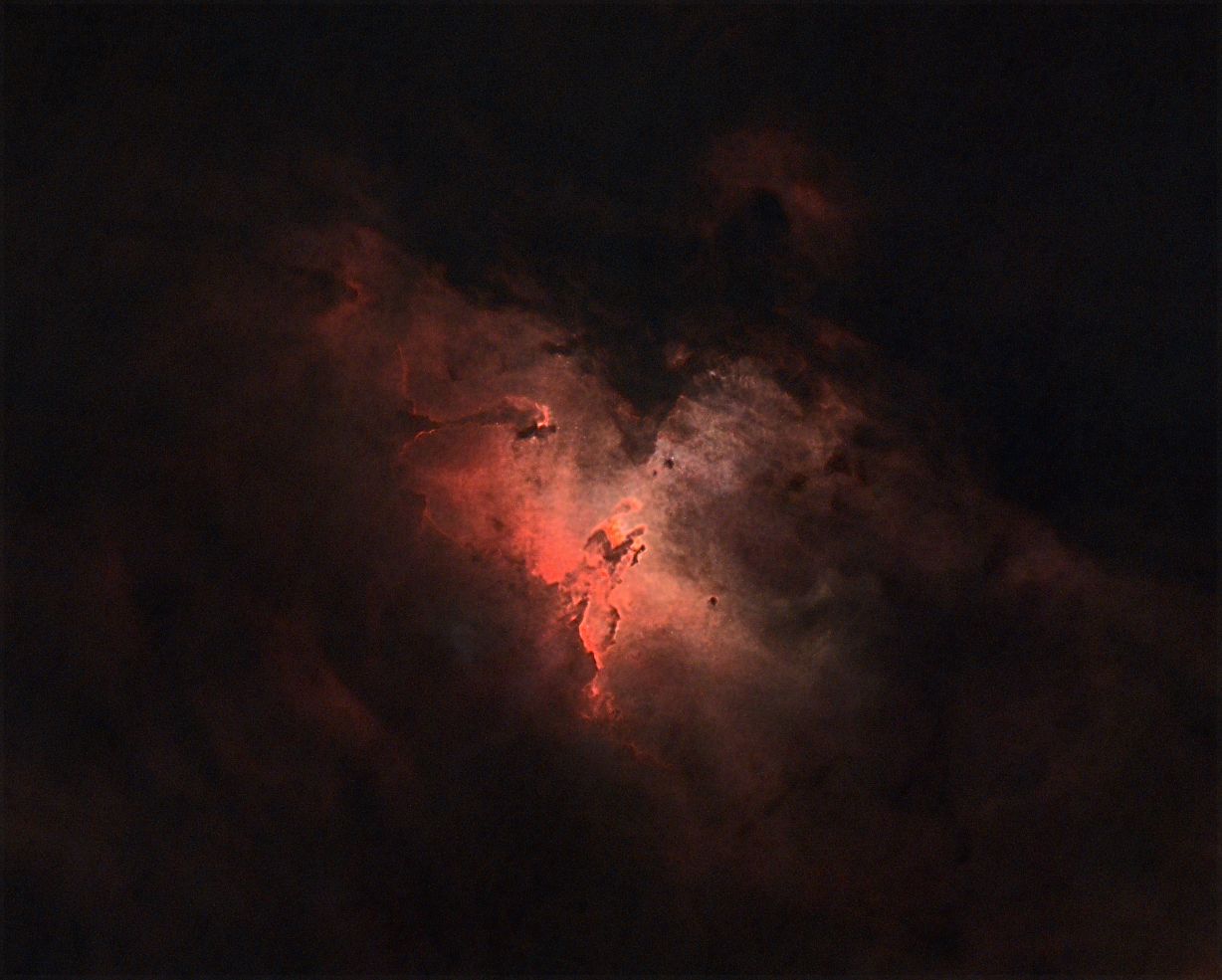The Eagle Nebula M16, one of the brightest night sky nebulae, is an area where stars are actively forming. It is filled with dark regions and globules, including a peculiar dark column named the “Stellar Spire”. Of special note are the “Pillars of Creation” made famous by an early (1995) picture from the Hubble Space Telescope. The pillars and spire are collapsing clouds of dust and gas being sculpted by intense starlight from newly formed hot stars.
Those newly-formed stars comprise the embedded star cluster NGC6611 and are the source that creates and lights up the cavity in the center of the nebula.
The Eagle Nebula (47 min total exposure Sep 9, 2023)

Making out the figures suggested by names of astronomical objects is rather like imagining figures formed by clouds in the daytime sky. The eagle I see is viewed from below and is flying toward the right. It has an overly large head extending to the upper right. Its outstretched wings extend to the upper left and lower right, and its feet extend down. Some people see the eagle plunging downward with the head at the bottom, the wings stretched right and left and the pillars of creation comprising its claws. Others have suggested that the nebula resembles a shamrock, or three-leaf clover. What do you see?
Miscellaneous notes and figures:
- The Eagle Nebula and star cluster NGC6611 are about 5700 light years away from us.
- The nebula covers an area of the sky very similar to the size of the full moon.
- The Eagle Nebula has also been called the Star Queen Nebula.
- The age of the star cluster has been estimated at 1-2 million years and the age of the nebula at about 5.5 million years.
- The pillars – which resemble stalagmites protruding from the floor of a cavern – are composed of interstellar hydrogen gas and dust, which act as incubators for new stars. Inside the columns and on their surface astronomers have found knots or globules of denser gas. Stars are being formed inside some of these.
- Why are the colors in Hubble images so different from my colors?
- Hubble images are all false color – meaning they start out as multiple black and white images taken in different parts of the spectrum (including the ultraviolet and the infrared). These multiple images are assigned visible colors and then combined into a false color image.
- For the Hubble “Pillars” image, light from singly-ionized sulphur shows as red, light from neutral hydrogen shows as green, and light from doubly-ionized oxygen shows as blue.
- My images are taken with a “One-shot color” camera and show actual colors you would see if you could see something as faint as the nebula.
An unusual view
I’ve used a special software program to remove the stars from the picture and let us see what the nebula itself looks like without the distraction of the foreground stars and the embedded star cluster. I think it looks quite spooky, perhaps like the entrance of a cave.
The Eagle Nebula minus stars (47 min total exposure Sep 9, 2023)

One of my earliest blog posts three years ago was also a look at the Eagle Nebula. In those days I was discovering what could be seen with relatively short exposures, what is known as EAA (electronically assisted astronomy). More recently I have transitioned into what is properly described as astrophotography, taking longer exposures and developing more skill at processing them. It’s interesting to compare the earlier image with the current one; click here to see it.